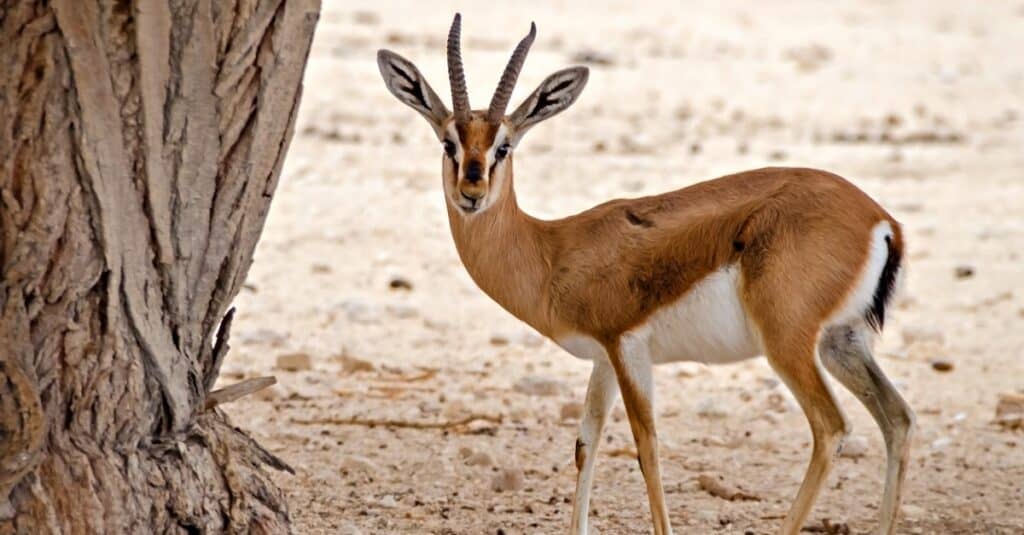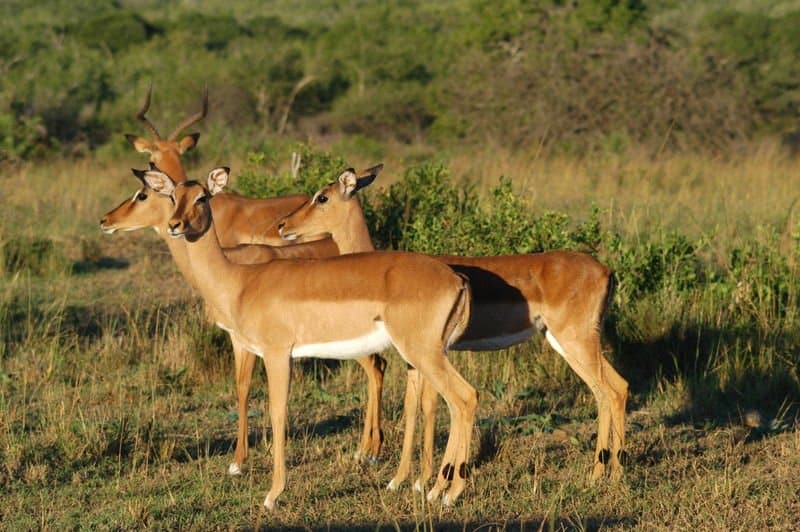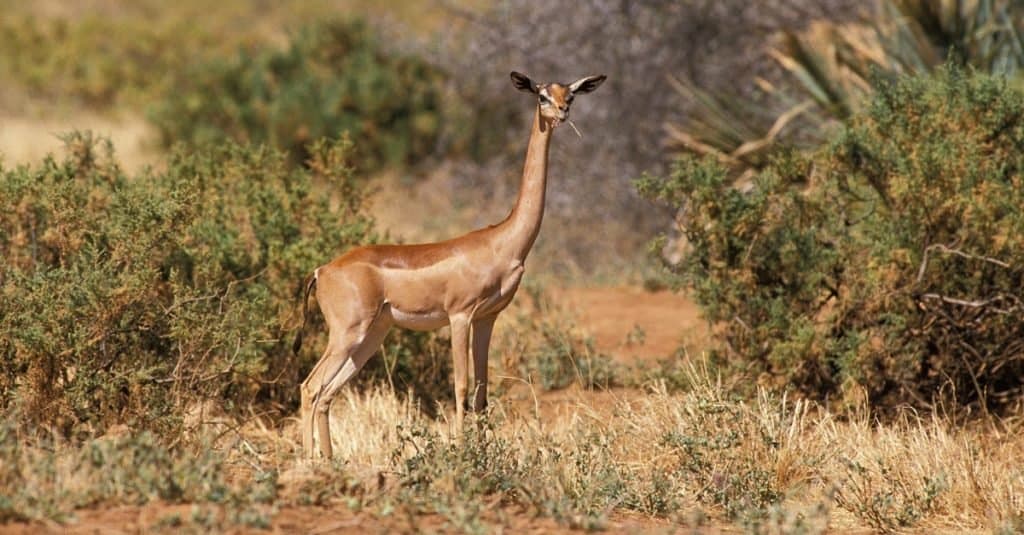Understanding the various groups and species of hooved ungulates worldwide can be difficult! In most Western languages, the terms gazelle, impala, and antelope are all used interchangeably to mean the same thing. While it may be common to use the terms to describe a deer-like animal in Africa, it isn’t quite accurate. Today, we are going to be learning about the differences between a Gazelle vs Impala to see what really makes them unique. Let’s get started!
Comparing a Gazelle and an Impala

| Gazelle | Impala | |
|---|---|---|
| Taxonomy | Classified as antelopes. Belong to the genus Gazella. | Classified as antelopes. Only members of the Aepyceros genus. |
| Horns | Males and females. | Males. |
| Size | Height: Between 2-4 feet on average. Weight: 26-160 lbs | Height: 3-5 feet on average. Weight: 88-170 lbs |
| Distribution | Africa, Asia | Southern Africa |
| Species | 17 distinct species. | One distinct species with two recognized subspecies. |
The 5 main differences between a gazelle and an impala
The main difference between a gazelle and an impala is that gazelles are a group of related antelope, while impalas are antelopes but don’t belong to the large taxonomic group known as gazelles.
Gazelles and impalas are two animals that most people can recognize right away. They are similar in appearance, generally live in Africa, and appear to be related to deer, albeit with some different biology. Still, despite these similarities, there are some distinct differences between these animals. In fact, one isn’t even referring to a species, but a group of animals!
Gazelles, in fact, aren’t a single species of deer-like Bovidae that live in Africa, they are a collectively grouped genus that includes about 17 distinct species. Impala, on the other hand, are a single species belonging to the Aepyceros genus. Both animals are antelopes, however, and are somewhat related. An easy way to remember their separation is this: gazelles are antelopes, but not all antelopes are gazelles. The impala is an antelope, but it isn’t a gazelle.
Aside from their scientific categories, gazelles and antelopes have some other differences. Namely, their horns, size, and distribution. Today, we are going to take a closer look at these differences to see what we can learn. Let’s get started!
Gazelle vs Impala: Taxonomy

Gazelles and impalas are both antelopes, but impalas don’t belong to the gazelle genus.
©iStock.com/gorsh13
As we’ve covered, gazelles are members of the Gazella genus and collectively represent about 17 unique species. Additionally, gazelles belong to a larger category of deer-like animals known as antelopes. The large category of antelopes includes members such as common eland, kudu, and nilgai. Gazelles are usually the smallest members of the antelope family, and all have similar traits to one another. Still, there are some discrepancies between the individual species.
Impalas are members of the Aepyceros genus and the only species in the group. Like gazelles, impalas are also classified as antelopes and are generally a bit larger than gazelles. There is only one gazelle species that is similar in size to the average impala.
Gazelle vs Impala: Horns

All gazelles can grow horns, but only male impalas can grow them.
©wayak/Shutterstock.com
Almost all members of the antelope family have horns. Unlike deer in North America, antelope horns never stop growing and don’t fall off. In gazelles, however, there isn’t any sexual dimorphism when it comes to their horns. In fact, both males and females of the group are able to grow horns.
One of the major differences that keep impalas out of the gazelle group is the sexual dimorphism of the horns. Impalas have long horns that continuously grow, just like gazelles, but only male impalas have the ability to grow them. You can tell female impalas from a distance due to their lack of ability to grow horns.
Gazelle vs Impala: Size

Most gazelles are much smaller than impalas.
©iStock.com/StuPorts
There is some general discrepancy when it comes to measuring “gazelles” since there are different species that can each measure differently. As a general rule, however, gazelles are the smallest members of the antelope family. Most are between 2-3.5 feet at the shoulder and weigh between 26 to 100 lbs. The largest member of the gazelle family, the dama gazelle, is the largest. They generally weigh between 88 and 165 lbs.
Impalas are larger than most gazelles and roughly the same size as the largest member of the gazelle family, the dama gazelle. Most impalas stand 3-5 feet at the shoulder and weigh between 88 and 170 lbs. There are other antelopes, however, that are significantly larger than any gazelle or impala.
Gazelle vs Impala: Distribution

Gazelles live in Africa, the Middle East, and central Asia. Impalas only live in southern Africa.
The gazelle has a much broader distribution than the impala. These diverse species primarily live in continental Africa but are also found in the Middle East, India, and central Asia. Asiatic gazelle have their own subgenus known as Procapra.
Impalas are exclusively found in Africa. Both recognized subspecies live south of the Horn of Africa, starting in Kenya. They live through the majority of the southern portion of Africa. The black-faced impala inhabits a small range in the western region of southern Africa along the border of Namibia and Angola.
Gazelle vs Impala: Species

There are 17 species of gazelle and only one species of impala.
©slowmotiongli/Shutterstock.com
The full list of gazelles is currently debated. Here are the most commonly identified species:
- Thomson’s gazelle – Eudorcas thomsonii
- Grant’s gazelle – Nager granti
- Gerenuk – Litocranius walleri
- Springbok – Antidorcas marsupialis
There is only one species of impala and two recognized subspecies. Additionally, there is a proposed six total subspecies, but they aren’t widely recognized based on DNA data. Here are the two subspecies:
- Common impala – A. m. melampus
- Black-faced impala – A. m. petersi
The photo featured at the top of this post is © iStock.com/gorsh13
Thank you for reading! Have some feedback for us? Contact the AZ Animals editorial team.






